Abstract
Background:
Antioxidant effects of propofol (2, 6-diisopropylphenol) were evaluated against cisplatin-induced oxidative stress in rat.Objectives:
In this experimental study, 20 male rats were equally divided into 4 groups (5 rats each), and were treated by propofol (10 mg/kg/day, IP), or cisplatin (7 mg /kg/day, IP), or both.Materials and Methods:
Group one was control, while group 2 was given cisplatin (7 mg /kg/day, IP). Animals of the third group received only propofol (10 mg/kg/day, IP). Group 4 was given propofol with cisplatin once per day for 7 days. After treatment, blood urea nitrogen, creatinine levels, and oxidative stress markers such as total thiol groups (TTG), lipid peroxidation (LPO), and total antioxidant capacity (TAC) were measured.Results:
Oxidative stress induced by cisplatin, was evident by a significant increase in LPO and decrease in TTG and TAC. Propofol recovered cisplatin -induced changes in TAC, TTG and LPO in blood.Conclusions:
It is concluded that oxidative damage is the mechanism of cisplatin toxicity, which can be recovered by propofol.Keywords
1. Background
In the treatment of malignancy and solid tumors, cisplatin acts as a strong anti-tumor compound. However, the chemotherapeutic property of cisplatin is limited because of its severe side effects such as ototoxicity and nephrotoxicity, which leads to decrease in cisplatin usage (1-3). Furthermore, cisplatin decreases antioxidant power in chemotherapy, as antitumor drugs induce production of free-radicals (4, 5). In previous studies, cisplatin-induced nephrotoxicity is strongly associated with increase in lipid peroxidation in kidney tissues (6). Propofol (2,6-diisopropylphenol) is a widely used intravenous sedative-hypnotic agent for both induction and maintenance of anesthesia and sedation in critically ill patients (7). Structure of the propofol contains a phenolic hydroxyl group and thus resembles that of α-tocopherol (vitamin E), a natural antioxidant. As shown by both in vitro and in vivo studies, the antioxidant activity of propofol results partly from this phenolic chemical structure (8).
Some studies have demonstrated antioxidant effects of propofol in vitro (9, 10) and some in vivo (11). However, propofol affects differently on different cells, and multiple mechanisms may be involved (12) in that. On the other hand, it has been reported that the antioxidant properties of propofol not only inhibit lipid peroxidation, but also scavenger and remove ROS that have been formed (8). Previous studies showed that induction of nephrotoxicity in cisplatin exposure is strongly associated with lipid peroxidation induction in kidney tissues (13). Recently, nephrotoxicity of cisplatin is controlled by sulforaphane through inhibition of antioxidant enzymes and decrease in oxidative or nitrosative stress (2, 14).
2. Objectives
In the present study, we investigated antioxidant properties of propofol on nephrotoxicity in rats treated with cisplatin.
3. Materials and Methods
Trichloroacetic acid (TCA), tetraethoxypropane (TEP), 2, 4, 6 tripyridyl-s-tiazine (TPTZ), 2-thiobarbituric acid (TBA), n- butanol, 2 thionitrobenzoic acid (DTNB), propofol (propofol-Lipuro 1%: Braun Melsungen AG Germany), ethylenediaminetetraacetic acid (EDTA), and cisplatin were used in this study. All other chemicals were obtained from the Sigma.
3.1. Animals and Treatments
In this experimental study, we used male Wistar rats of 180-250 g body weight kept at a 12:12 h light-dark cycle with free access to drinking water and standard laboratory chow. Animals were randomly divided into six groups (5 rats in each group) and then, treated intraperitoneally (IP) for one week.
The design of these treatments resulted in four experimental groups. The groups were as follows: propofol group, control group, cisplatin group, and propofol with cisplatin group. Then, propofol was administered (10 mg/kg/day, IP) (15, 16) alone or in mixture with cisplatin (7 mg /kg/day, IP) (13, 17). Also, control group received only normal saline. Finally, animals were killed 24 hours after the last dose of treatment, and their blood was taken. Blood samples were collected in heparinized tubes, and plasma was immediately separated.
3.2. Kidney Parameters
In present study, blood urea nitrogen (BUN) and creatinine (Cr) levels were measured by automated biochemistry machine aaccording to the standard procedure of Pars azmoon kits.
3.3. Oxidative Stress Biomarkers
Oxidative biomarkers in this study such as lipid peroxidation, total antioxidant capacity and total thiol molecules were measured.
3.4. Measurement of Lipid Peroxidation
In this method, lipid peroxidation (LPO) product in the tissues was determined by thiobarbituric acid (TBA) reagent during an acid heating reaction that expressed the amount of malondialdehyde (MDA) production. At the end, calibration curve of tetramethoxypropane standard solution was used to determine the concentrations of TBA- MDA adduct in the samples (18).
3.5. Measurement of Total Antioxidant Capacity
In this study, total antioxidant capacity (TAC) was calculated with ferric reducing ability of plasma (FRAP) assay. This process is founded upon the ability of plasma in reducing Fe3 + to Fe2 + in the presence of TPTZ. Also, the reaction of Fe2 + with TPTZ gives a complex with blue color and maximum absorption at 593 nm (19).
3.6. Assay of Total Thiol Molecules
In this protocol, total thiol molecules (TTG) evaluated with DTNB reagent. Thiol molecules react with DTNB and create a yellow complex with excellent absorption in spectrophotometer at 412 nm (20).
3.7. Statistical Analysis
Reported data were mean ± SEM of at least three independent experiments performed two times or more. The 1-way analysis of variance (ANOVA), followed by a Tukey post hoc test, was used to compare multiple groups, and all comparisons were significant when P < 0.05.
4. Results
Kidney parameters of creatinine (Cr) level and blood urea nitrogen (BUN) in animal tests are shown in Figure 1 and 2. Propofol caused a significant reduction in Cr and BUN compared with the control group (P = 0.001, P = 0.02, respectively).
4.1. Oxidative Stress Parameters
4.1.1. Lipid Peroxidation
Cisplatin changed a significant increase in LPO compared with the control group (P = 0.03). Propofol induced a significant decrease in LPO compared with the cisplatin group (P = 0.03). Coadministration of cisplatin with propofol decreased cisplatin-induced LPO (P = 0.04) (Figure 3).
4.2. Total Thiol Molecules
The value of TTG in propofol group was not significantly different from the control and other groups (Figure 4).
4.3. Total Antioxidant Capacity
Cisplatin caused a significant decrease in TAC when compared with the control group (P = 0.001). Treatment with propofol improved TAC compared with the cisplatin group (P = 0.04). Coadministration of cisplatin with propofol significantly increased TAC level compared with the cisplatin group (P = 0.02) (Figure 5).
Creatinine (mg/dL) Level of Blood Rats
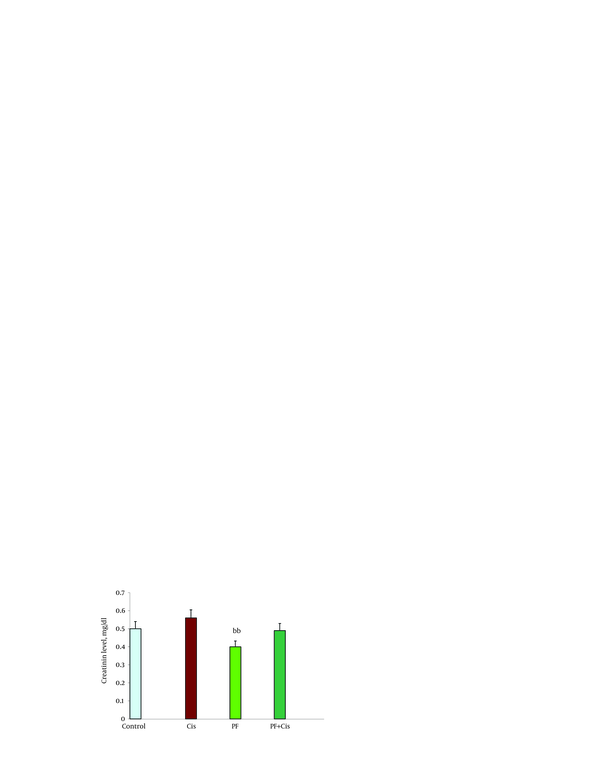
Blood Urea Nitrogen (mg/dL) Level of Rats
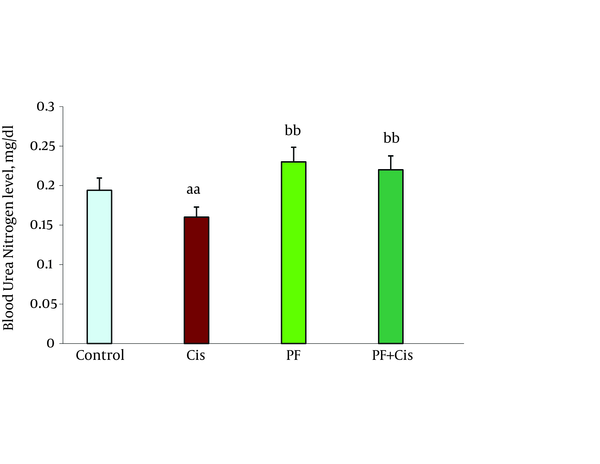
Lipid Peroxidation (LPO) Level in Blood Rats
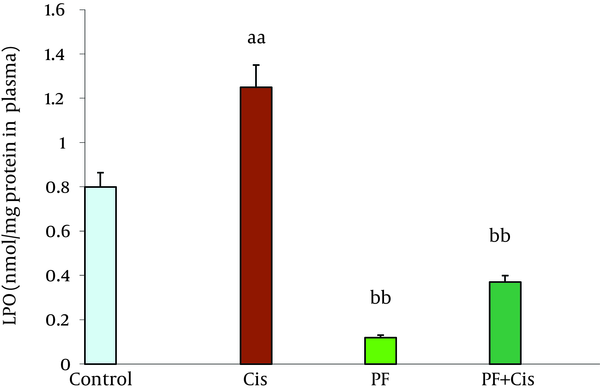
Total Thiol Molecules (TTM) in Blood Rats
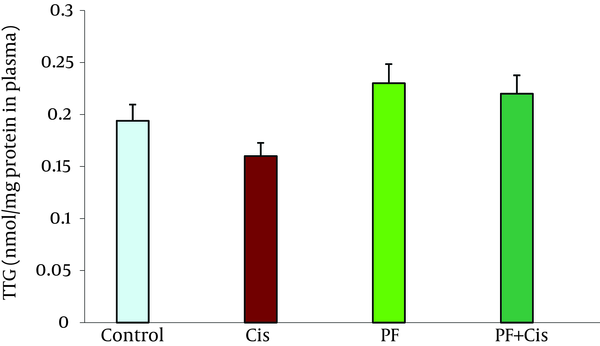
Total Antioxidant Capacity (TAC) in Blood Rats
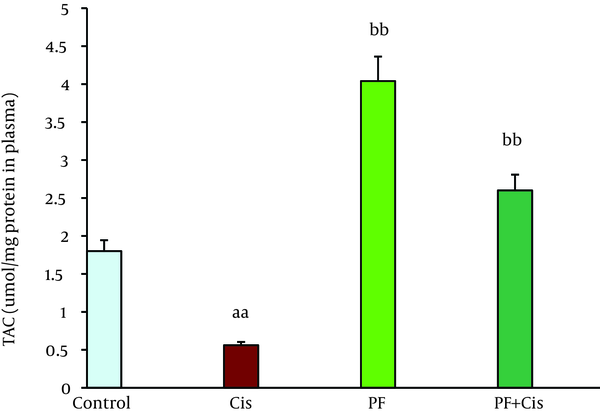
5. Discussion
General findings in this study showed the possible toxicity of cisplatin through increasing oxidative injuries. Results indicated that oxidative markers such as LPO, TAC, and TTG are stimulated in contact with cisplatin, although their defense is not sufficient to induce free radicals production. The present results also showed that TTG is decreased by cisplatin. However, propofol indicates antioxidant properties throhout reduction oxidative stress induced by cisplatin. On the other hand, cisplatin toxicity of oxidative reactive agents is characterized by increase in BUN and Cr in the serum. Indeed, oxidative stress induction in cisplatin toxicity is indicated by the increase in ROS and fouling cellular damage as shown by an increase in LPO and decrease in TAC and TTG.
Propofol effect may be due to its chemically similar structure to endogenous antioxidant α-tocopherol (Vitamin E) and theoretically should show similar properties (21). The present result indicates reduction of LPO in the propofol treatment group induced by cisplatin. Numerous antioxidants as free radical scavengers, including flavonoids, vitamin E and vitamin C were reported to have various protective effects in cisplatin-induced damage (4, 22, 23). The antioxidant effects of propofol may also be due to its capacity in attenuating the formation of lipid peroxides (24), inducing the expression of antioxidant enzyme home oxygenase-1 (10), decreasing the expression of nitric oxide synthase (NOS), (25) and fixing the mitochondrial membrane (26).
Our findings showed that, propofol activates oxidative biomarkers against cisplatin toxicity in plasma. In kidney, cisplatin increases production of oxidative stress biomarkers in nephrotoxicity (13, 27) and produces ROS such as hydroxyl radical and superoxide anion (14, 28). Previous studies showed that increased cisplatin induces LPO biomarkers production such as MDA, 4-hydroxy-2-nonenal (4-HNE), and 8-isoprostane (27, 29, 30). We think it is due to the antioxidant properties of propofol in the blood. Propofol was also shown to endorse mitochondrial activity by stabilizing the transmembrane electrical potential (31, 32) and inhibiting mitochondrial permeability transition pore openings (33), both contributing to suppression of mitochondrion-dependent apoptotic signaling (34).
The damages induced by cisplatin are resulted from free radicals through lipid peroxidation of cell membranes, reduction in antioxidant enzyme and antioxidant substrates to induce oxidative stress, which is the main factor in acute and chronic injuries in different tissues (35). In this study, cisplatin exposure causes a significant increase in LPO production. Most significantly, propofol decreased LPO (Figure 3). These findings are consistent with previous investigations using a variety of antioxidant uptakes (36-38). Recently, in vitro studies showed that propofol could efficiently suppress apoptotic signaling and prevent apoptotic death of myocardial cells encountering fatal stimuli (10, 39, 40). Propofol in experiments on heart tissuess, reversed mitochondrial permeability transition (33) and reduced ischemia–reperfusion damage (41-43). These conclusions support the idea that propofol can prevent the sequences of oxidative stress. Interestingly, as evidenced oxidative damage, these results verify that cisplatin-induced oxidative damage could be improved by propofol. Nevertheless, the strict molecular and cellular mechanisms of an accepted role of propofol (protective role) should be investigated in the future.
Acknowledgements
References
-
1.
Boulikas T, Vougiouka M. Cisplatin and platinum drugs at the molecular level. (Review). Oncol Rep. 2003;10(6):1663-82. [PubMed ID: 14534679].
-
2.
Yao X, Panichpisal K, Kurtzman N, Nugent K. Cisplatin nephrotoxicity: a review. Am J Med Sci. 2007;334(2):115-24. [PubMed ID: 17700201]. https://doi.org/10.1097/MAJ.0b013e31812dfe1e.
-
3.
Rybak LP, Mukherjea D, Jajoo S, Ramkumar V. Cisplatin ototoxicity and protection: clinical and experimental studies. Tohoku J Exp Med. 2009;219(3):177-86. [PubMed ID: 19851045].
-
4.
Ravi R, Somani SM, Rybak LP. Mechanism of cisplatin ototoxicity: antioxidant system. Pharmacol Toxicol. 1995;76(6):386-94. [PubMed ID: 7479581].
-
5.
Arjumand W, Seth A, Sultana S. Rutin attenuates cisplatin induced renal inflammation and apoptosis by reducing NFkappaB, TNF-alpha and caspase-3 expression in wistar rats. Food Chem Toxicol. 2011;49(9):2013-21. [PubMed ID: 21605616]. https://doi.org/10.1016/j.fct.2011.05.012.
-
6.
Antunes LM, Darin JD, Bianchi MD. Protective effects of vitamin c against cisplatin-induced nephrotoxicity and lipid peroxidation in adult rats: a dose-dependent study. Pharmacol Res. 2000;41(4):405-11. [PubMed ID: 10704263]. https://doi.org/10.1006/phrs.1999.0600.
-
7.
Marik PE. Propofol: An Immunomodulating Agent. Pharmacy. 2005;25(5 Part 2):28S-33S. https://doi.org/10.1592/phco.2005.25.5_Part_2.28S.
-
8.
Ansley DM, Lee J, Godin DV, Garnett ME, Qayumi AK. Propofol enhances red cell antioxidant capacity in swine and humans. Can J Anaesth. 1998;45(3):233-9. [PubMed ID: 9579261].
-
9.
Tesauro M, Thompson WC, Moss J. Effect of staurosporine-induced apoptosis on endothelial nitric oxide synthase in transfected COS-7 cells and primary endothelial cells. Cell Death Differ. 2006;13(4):597-606. [PubMed ID: 16195740]. https://doi.org/10.1038/sj.cdd.4401770.
-
10.
Xu JJ, Wang YL. Propofol attenuation of hydrogen peroxide-mediated oxidative stress and apoptosis in cultured cardiomyocytes involves haeme oxygenase-1. Eur J Anaesthesiol. 2008;25(5):395-402. [PubMed ID: 18289444]. https://doi.org/10.1017/S0265021508003542.
-
11.
Kobayashi K, Yoshino F, Takahashi SS, Todoki K, Maehata Y, Komatsu T, et al. Direct assessments of the antioxidant effects of propofol medium chain triglyceride/long chain triglyceride on the brain of stroke-prone spontaneously hypertensive rats using electron spin resonance spectroscopy. Anesthesiology. 2008;109(3):426-35. [PubMed ID: 18719440]. https://doi.org/10.1097/ALN.0b013e318182a903.
-
12.
Chen J, Gu Y, Shao Z, Luo J, Tan Z. Propofol protects against hydrogen peroxide-induced oxidative stress and cell dysfunction in human umbilical vein endothelial cells. Mol Cell Biochem. 2010;339(1-2):43-54. [PubMed ID: 20039104]. https://doi.org/10.1007/s11010-009-0368-y.
-
13.
Ulu R, Dogukan A, Tuzcu M, Gencoglu H, Ulas M, Ilhan N, et al. Regulation of renal organic anion and cation transporters by thymoquinone in cisplatin induced kidney injury. Food Chem Toxicol. 2012;50(5):1675-9. [PubMed ID: 22414646]. https://doi.org/10.1016/j.fct.2012.02.082.
-
14.
Chirino YI, Pedraza-Chaverri J. Role of oxidative and nitrosative stress in cisplatin-induced nephrotoxicity. Exp Toxicol Pathol. 2009;61(3):223-42. [PubMed ID: 18986801]. https://doi.org/10.1016/j.etp.2008.09.003.
-
15.
Ozturk E, Demirbilek S, Koroglu A, But A, Begec ZO, Gulec M, et al. Propofol and erythropoietin antioxidant properties in rat brain injured tissue. Prog Neuropsychopharmacol Biol Psychiatry. 2008;32(1):81-6. [PubMed ID: 17764798]. https://doi.org/10.1016/j.pnpbp.2007.07.016.
-
16.
Ranjbar A, Ghahremani MH, Sharifzadeh M, Golestani A, Ghazi-Khansari M, Baeeri M, et al. Protection by pentoxifylline of malathion-induced toxic stress and mitochondrial damage in rat brain. Hum Exp Toxicol. 2010;29(10):851-64. [PubMed ID: 20194575]. https://doi.org/10.1177/0960327110363836.
-
17.
Abdollahi M, Ranjbar A, Shadnia S, Nikfar S, Rezaie A. Pesticides and oxidative stress: a review. Med Sci Monit. 2004;10(6):RA141-7. [PubMed ID: 15173684].
-
18.
Moore K, Roberts LJ. Measurement of Lipid Peroxidation. Free Radical Res. 1998;28(6):659-71. https://doi.org/10.3109/10715769809065821.
-
19.
Benzie IF, Strain JJ. The ferric reducing ability of plasma (FRAP) as a measure of "antioxidant power": the FRAP assay. Anal Biochem. 1996;239(1):70-6. [PubMed ID: 8660627]. https://doi.org/10.1006/abio.1996.0292.
-
20.
Hu M, Dillard C. Plasma SH and GSH measurement. Methods Enzymol. 1994;233(385):87.
-
21.
Bayona NA, Gelb AW, Jiang Z, Wilson JX, Urquhart BL, Cechetto DF. Propofol neuroprotection in cerebral ischemia and its effects on low-molecular-weight antioxidants and skilled motor tasks. Anesthesiology. 2004;100(5):1151-9. [PubMed ID: 15114212].
-
22.
Abderrezak A, Bourassa P, Mandeville JS, Sedaghat-Herati R, Tajmir-Riahi HA. Dendrimers bind antioxidant polyphenols and cisplatin drug. PLoS One. 2012;7(3). [PubMed ID: 22427960]. https://doi.org/10.1371/journal.pone.0033102.
-
23.
Naziroglu M, Karaoglu A, Aksoy AO. Selenium and high dose vitamin E administration protects cisplatin-induced oxidative damage to renal, liver and lens tissues in rats. Toxicology. 2004;195(2-3):221-30. [PubMed ID: 14751677].
-
24.
Kahraman S, Kilinc K, Dal D, Erdem K. Propofol attenuates formation of lipid peroxides in tourniquet-induced ischaemia-reperfusion injury. Br J Anaesth. 1997;78(3):279-81. [PubMed ID: 9135305].
-
25.
Goode HF, Cowley HC, Walker BE, Howdle PD, Webster NR. Decreased antioxidant status and increased lipid peroxidation in patients with septic shock and secondary organ dysfunction. Crit Care Med. 1995;23(4):646-51. [PubMed ID: 7712754].
-
26.
Eriksson O. Effects of the general anaesthetic Propofol on the Ca2+-induced permeabilization of rat liver mitochondria. FEBS Letters. 1991;279(1):45-8. https://doi.org/10.1016/0014-5793(91)80246-y.
-
27.
Dogukan A, Tuzcu M, Agca CA, Gencoglu H, Sahin N, Onderci M, et al. A tomato lycopene complex protects the kidney from cisplatin-induced injury via affecting oxidative stress as well as Bax, Bcl-2, and HSPs expression. Nutr Cancer. 2011;63(3):427-34. [PubMed ID: 21391123]. https://doi.org/10.1080/01635581.2011.535958.
-
28.
Kruidering M, Van de Water B, de Heer E, Mulder GJ, Nagelkerke JF. Cisplatin-induced nephrotoxicity in porcine proximal tubular cells: mitochondrial dysfunction by inhibition of complexes I to IV of the respiratory chain. J Pharmacol Exp Ther. 1997;280(2):638-49. [PubMed ID: 9023274].
-
29.
Yousef MI, Saad AA, El-Shennawy LK. Protective effect of grape seed proanthocyanidin extract against oxidative stress induced by cisplatin in rats. Food Chem Toxicol. 2009;47(6):1176-83. [PubMed ID: 19425235]. https://doi.org/10.1016/j.fct.2009.02.007.
-
30.
Silici S, Ekmekcioglu O, Kanbur M, Deniz K. The protective effect of royal jelly against cisplatin-induced renal oxidative stress in rats. World J Urol. 2011;29(1):127-32. [PubMed ID: 20369241]. https://doi.org/10.1007/s00345-010-0543-5.
-
31.
Branca D, Roberti MS, Lorenzin P, Vincenti E, Scutari G. Influence of the anesthetic 2,6-diisopropylphenol on the oxidative phosphorylation of isolated rat liver mitochondria. Biochem Pharmacy. 1991;42(1):87-90. https://doi.org/10.1016/0006-2952(91)90684-w.
-
32.
Tsujimoto Y, Shimizu S. Role of the mitochondrial membrane permeability transition in cell death. Apoptosis. 2007;12(5):835-40. [PubMed ID: 17136322]. https://doi.org/10.1007/s10495-006-0525-7.
-
33.
Javadov S. Protection of hearts from reperfusion injury by propofol is associated with inhibition of the mitochondrial permeability transition. Cardiovasc Res. 2000;45(2):360-9. https://doi.org/10.1016/s0008-6363(99)00365-x.
-
34.
Crompton M. The mitochondrial permeability transition pore and its role in cell death. Biochem J. 1999;341 ( Pt 2):233-49. [PubMed ID: 10393078].
-
35.
Szymonik-Lesiuk S, Czechowska G, Stryjecka-Zimmer M, Slomka M, Madro A, Celinski K, et al. Catalase, superoxide dismutase, and glutathione peroxidase activities in various rat tissues after carbon tetrachloride intoxication. J Hepatobiliary Pancreat Surg. 2003;10(4):309-15. [PubMed ID: 14598152]. https://doi.org/10.1007/s00534-002-0824-5.
-
36.
Pace A, Giannarelli D, Galie E, Savarese A, Carpano S, Della Giulia M, et al. Vitamin E neuroprotection for cisplatin neuropathy: a randomized, placebo-controlled trial. Neurology. 2010;74(9):762-6. [PubMed ID: 20194916]. https://doi.org/10.1212/WNL.0b013e3181d5279e.
-
37.
Mise T, Yasumoto T. Simultaneous Treatment of Cancer Cells Lines with the Anticancer Drug Cisplatin and the Antioxidant Fucoxanthin. Br Pharmacol J. 2011.
-
38.
Durak I, Ozbek H, Karaayvaz M, Ozturk HS. Cisplatin induces acute renal failure by impairing antioxidant system in guinea pigs: effects of antioxidant supplementation on the cisplatin nephrotoxicity. Drug Chem Toxicol. 2002;25(1):1-8. [PubMed ID: 11850966]. https://doi.org/10.1081/DCT-100108468.
-
39.
Kim HS, Chang WC, Hwang KC, Choi IG, Park WK. Effect of propofol on calcium homeostasis in hypoxia-reoxygenated neonatal rat cardiomyocytes. Eur J Pharmacol. 2008;594(1-3):139-45. [PubMed ID: 18674530]. https://doi.org/10.1016/j.ejphar.2008.07.027.
-
40.
Noh HS, Shin IW, Ha JH, Hah YS, Baek SM, Kim DR. Propofol protects the autophagic cell death induced by the ischemia/reperfusion injury in rats. Mol Cells. 2010;30(5):455-60. [PubMed ID: 20821058]. https://doi.org/10.1007/s10059-010-0130-z.
-
41.
Ko SH, Yu C, Lee SK, Choe H, Chung MJ, Kwak YG, et al. Propofol Attenuates Ischemia-Reperfusion Injury in the Isolated Rat Heart. Anesth Analg. 1997;85(4):719-24. https://doi.org/10.1213/00000539-199710000-00002.
-
42.
Xia WF, Liu Y, Zhou QS, Tang QZ, Zou HD. Comparison of the effects of propofol and midazolam on inflammation and oxidase stress in children with congenital heart disease undergoing cardiac surgery. Yonsei Med J. 2011;52(2):326-32. [PubMed ID: 21319354]. https://doi.org/10.3349/ymj.2011.52.2.326.
-
43.
Lai HC, Yeh YC, Wang LC, Ting CT, Lee WL, Lee HW, et al. Propofol ameliorates doxorubicin-induced oxidative stress and cellular apoptosis in rat cardiomyocytes. Toxicol Appl Pharmacol. 2011;257(3):437-48. [PubMed ID: 22015447]. https://doi.org/10.1016/j.taap.2011.10.001.